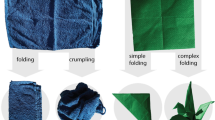Abstract
We describe a method of analogical reasoning for the task of constructing a Structure Behavior Function (SBF) model of a physical system from its drawing. A DSSBF (Drawing Shape Structure Behavior Function) model relates the SBF model of a system to its drawing. A DSSBF model of a target drawing is constructed by analogy to the DSSBF model of a very similar drawing. In this paper, we focus on the tasks of analogical mapping between target and source drawings and transfer of the DSSBF model of the source drawing to the target drawing. Archytas is a computer program that implements this analogical method for model construction in the domain of simple kinematics devices.
Access this chapter
Tax calculation will be finalised at checkout
Purchases are for personal use only
Preview
Unable to display preview. Download preview PDF.
Similar content being viewed by others
References
Börner, K, Eberhard, P, Tammer, E-C, and Coulon, C-H: 1996, Structural similarity in adaptation, in I Smith and B Fallings (eds), Lecture Notes in Artificial Intelligence, Springer-Verlag, 1168: 58–75.
Chandrasekaran, B, Goel, AK, and Iwasaki, Y: 1993, Functional representation as design rationale, IEEE Computer 26: 48–56.
Chen, CK and Yun, DYY: 1998, Unifying graph matching problems with a common solution, Proc. Int’I Conf. on Systems, Signals, Control, and Computers.
Do, EY-L, and Gross, MD: 1995, Drawing analogies: finding visual references by sketching, Proc. Association of Computer-Aided Design in Architecture, National Conf., ACADIA, pp. 35–52.
Falkenhainer, B, Forbus, K and Getner, D: 1990, The structure mapping engine: Algorithm and examples, Artificial Intelligence 41: 1–63.
Ferguson, RW, and Forbus, KD: 1998, Telling juxtapositions: using repetition and alignable difference in diagram understanding, in K Holyoak, D Gentner, and B Kokinov (eds), Advances in Analogy Research, New Bulgaria University, Sofia, Bulgaria, pp. 109–117.
Ferguson, RW, and Forbus, KD: 2000, GeoRep: A flexible tool for spatial representation of line drawings, in Proc. 17th National Conf. on Artificial Intelligence (AAAI-2000), AAAI Press, pp. 510–516.
Gephardt, F, Voss, A, Grather, W, and Schmidt-Belz, B: 1997, Reasoning with Complex Cases, Kluwer Academic Publishers, Dordrecht.
Gero, J and McNeil, T: 1998, An approach to the analysis of design protocols, Design Studies 19: 21–61.
Gero, J, Tham, K, and Lee, S: 1992, Behavior: a link between function and structure, in DC Brown, MB Waldron, and H Yoshikawa, (eds), Intelligent Computer-Aided Design, North-Holland, pp. 193–225.
Goel, AK: 1991, A model-based approach to case adaptation, Proc. 13 Annual Conf. of the Cognitive Science Society, Lawrence Erlbaum Associates, pp. 143–148.
Goel, AK and Chandrasekaran, B: 1989, Functional representation of designs and redesign problem solving, Proc. 11th Int’lJoint Conf. on Artificial Intelligence (IJCAI-89), Morgan Kaufmann, pp. 1388–1394.
Goel, AK and Chandrasekaran, B: 1992, Case-based design: a task analysis, in C Tong and D Sriram, (eds), Artificial Intelligence Approaches to Engineering Design, Volume II: Innovative Design, Academic Press, San Diego, CA, pp. 165–184.
Holyoak, K and Thagard, P: 1989, Analogical mapping by constraint satisfaction, Cognitive Science 13: 295–355.
Rasmussen, J: 1985, The role of hierarchical knowledge representation in decision making and system management, IEEE Transactions on Systems, Man, and Cybernetics 15: 234–243.
Raymond, JW, Gardiner, EJ, and Willett, P: 2002, Heuristics for similarity searching of chemical graphs using a maximum common edge subgraph algorithm, J. Chem. Inf. Comput. Sci. 42: 305–316.
Sembugamoorthy, V and Chandrasekaran, B: 1986, Functional representation of devices and compilation of diagnostic problem-solving systems, in J Kolodner and C Riesbeck (eds), Experience, Memory, and Reasoning, Lawrence Erlbaum, Hillsdale, NJ, pp. 47–73.
Stahovich, TF, Davis, R, and Shrobe, H: 2001, Generating multiple new designs from a sketch, Artificial Intelligence 104: 211–264.
Umeda, Y, Takeda, H, Tomiyama, T, and Yoshikawa, H: 1990, Function, behavior, and structure, Proc. 5th Int’l Conf. on Applications of AI in Engineering, vol. 1, Springer-Verlag, pp. 177–193.
Yaner, P and Goel, A: 2004, Visual analogy: reexamining analogy as a constraint satisfaction problem, Proc. 26th Annual Meeting of the Cognitive Science Society, pp. 1482–1487.
Author information
Authors and Affiliations
Editor information
Editors and Affiliations
Rights and permissions
Copyright information
© 2006 Springer
About this paper
Cite this paper
YANER, P.W., GOEL, A.K. (2006). FROM FORM TO FUNCTION: FROM SBF TO DSSBF. In: GERO, J.S. (eds) Design Computing and Cognition ’06. Springer, Dordrecht. https://doi.org/10.1007/978-1-4020-5131-9_22
Download citation
DOI: https://doi.org/10.1007/978-1-4020-5131-9_22
Publisher Name: Springer, Dordrecht
Print ISBN: 978-1-4020-5130-2
Online ISBN: 978-1-4020-5131-9
eBook Packages: EngineeringEngineering (R0)




